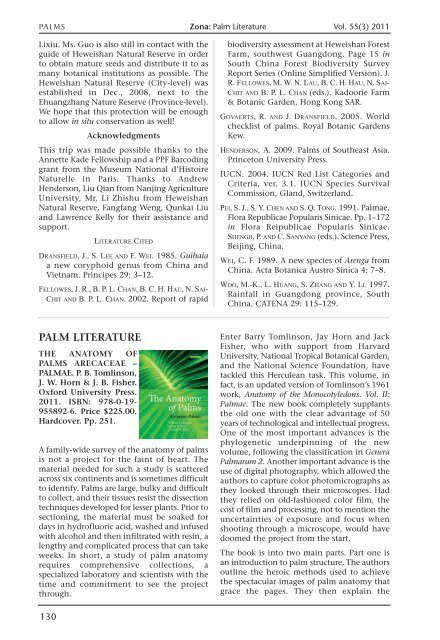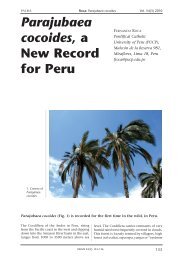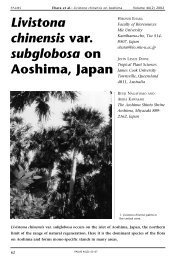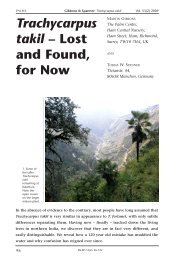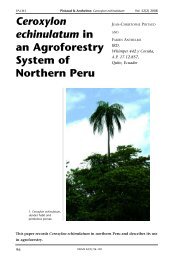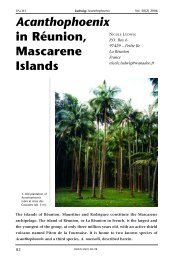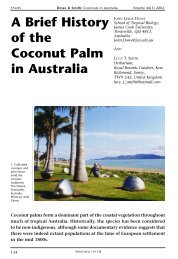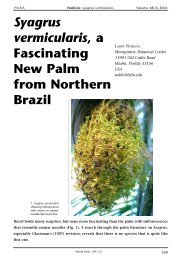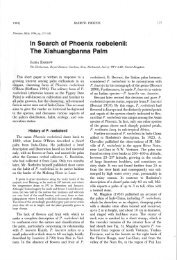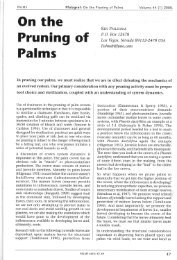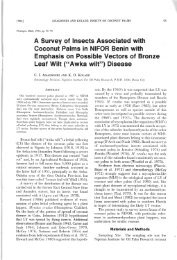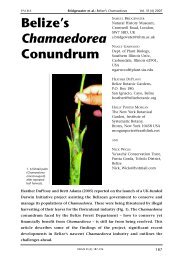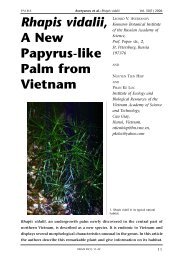Arenga longicarpa, a Poorly Known Species from South China
Arenga longicarpa, a Poorly Known Species from South China
Arenga longicarpa, a Poorly Known Species from South China
Create successful ePaper yourself
Turn your PDF publications into a flip-book with our unique Google optimized e-Paper software.
PALMS Zona: Palm Literature Vol. 55(3) 2011<br />
Lixiu. Ms. Guo is also still in contact with the<br />
guide of Heweishan Natural Reserve in order<br />
to obtain mature seeds and distribute it to as<br />
many botanical institutions as possible. The<br />
Heweishan Natural Reserve (City-level) was<br />
established in Dec., 2008, next to the<br />
Ehuangzhang Nature Reserve (Province-level).<br />
We hope that this protection will be enough<br />
to allow in situ conservation as well!<br />
Acknowledgments<br />
This trip was made possible thanks to the<br />
Annette Kade Fellowship and a PPF Barcoding<br />
grant <strong>from</strong> the Museum National d’Histoire<br />
Naturelle in Paris. Thanks to Andrew<br />
Henderson, Liu Qian <strong>from</strong> Nanjing Agriculture<br />
University, Mr. Li Zhishu <strong>from</strong> Heweishan<br />
Natural Reserve, Fangfang Weng, Qunkai Liu<br />
and Lawrence Kelly for their assistance and<br />
support.<br />
liteRatuRe Cited<br />
dRaNsField, J., s. lee aNd F. wei. 1985. Guihaia<br />
a new coryphoid genus <strong>from</strong> <strong>China</strong> and<br />
Vietnam. Principes 29: 3–12.<br />
Fellowes, J. R., B. P. l. CHaN, B. C. H. Hau, N. sai-<br />
CHit aNd B. P. l. CHaN. 2002. Report of rapid<br />
biodiversity assessment at Heweishan Forest<br />
Farm, southwest Guangdong. Page 15 in<br />
<strong>South</strong> <strong>China</strong> Forest Biodiversity Survey<br />
Report Series (Online Simplified Version). J.<br />
R. Fellowes, M. w. N. lau, B. C. H. Hau, N. sai-<br />
CHit aNd B. P. l. CHaN (eds.). Kadoorie Farm<br />
& Botanic Garden, Hong Kong SAR.<br />
GovaeRts, R. aNd J. dRaNsField. 2005. World<br />
checklist of palms. Royal Botanic Gardens<br />
Kew.<br />
HeNdeRsoN, A. 2009. Palms of <strong>South</strong>east Asia.<br />
Princeton University Press.<br />
IUCN. 2004. IUCN Red List Categories and<br />
Criteria, ver. 3.1. IUCN <strong>Species</strong> Survival<br />
Commission, Gland, Switzerland.<br />
Pei, s. J., s. Y. CHeN aNd s. Q. toNG. 1991. Palmae.<br />
Flora Republicae Popularis Sinicae. Pp. 1–172<br />
in Flora Reipublicae Popularis Sinicae.<br />
sHeNGJi, P. aNd C. saNYaNG (eds.). Science Press,<br />
Beijing, <strong>China</strong>.<br />
wei, C. F. 1989. A new species of <strong>Arenga</strong> <strong>from</strong><br />
<strong>China</strong>. Acta Botanica Austro Sinica 4: 7–8.<br />
woo, M.-K., l. HuaNG, s. ZHaNG aNd Y. li. 1997.<br />
Rainfall in Guangdong province, <strong>South</strong><br />
<strong>China</strong>. CATENA 29: 115–129.<br />
PALM LITERATURE<br />
THE ANATOMY OF<br />
PALMS ARECACEAE –<br />
PALMAE. P. B. Tomlinson,<br />
J. W. Horn & J. B. Fisher.<br />
Oxford University Press.<br />
2011. ISBN: 978-0-19-<br />
955892-6. Price $225.00.<br />
Hardcover. Pp. 251.<br />
A family-wide survey of the anatomy of palms<br />
is not a project for the faint of heart. The<br />
material needed for such a study is scattered<br />
across six continents and is sometimes difficult<br />
to identify. Palms are large, bulky and difficult<br />
to collect, and their tissues resist the dissection<br />
techniques developed for lesser plants. Prior to<br />
sectioning, the material must be soaked for<br />
days in hydrofluoric acid, washed and infused<br />
with alcohol and then infiltrated with resin, a<br />
lengthy and complicated process that can take<br />
weeks. In short, a study of palm anatomy<br />
requires comprehensive collections, a<br />
specialized laboratory and scientists with the<br />
time and commitment to see the project<br />
through.<br />
Enter Barry Tomlinson, Jay Horn and Jack<br />
Fisher, who with support <strong>from</strong> Harvard<br />
University, National Tropical Botanical Garden,<br />
and the National Science Foundation, have<br />
tackled this Herculean task. This volume, in<br />
fact, is an updated version of Tomlinson’s 1961<br />
work, Anatomy of the Monocotyledons. Vol. II:<br />
Palmae. The new book completely supplants<br />
the old one with the clear advantage of 50<br />
years of technological and intellectual progress.<br />
One of the most important advances is the<br />
phylogenetic underpinning of the new<br />
volume, following the classification in Genera<br />
Palmarum 2. Another important advance is the<br />
use of digital photography, which allowed the<br />
authors to capture color photomicrographs as<br />
they looked through their microscopes. Had<br />
they relied on old-fashioned color film, the<br />
cost of film and processing, not to mention the<br />
uncertainties of exposure and focus when<br />
shooting through a microscope, would have<br />
doomed the project <strong>from</strong> the start.<br />
The book is into two main parts. Part one is<br />
an introduction to palm structure. The authors<br />
outline the heroic methods used to achieve<br />
the spectacular images of palm anatomy that<br />
grace the pages. They then explain the<br />
130


